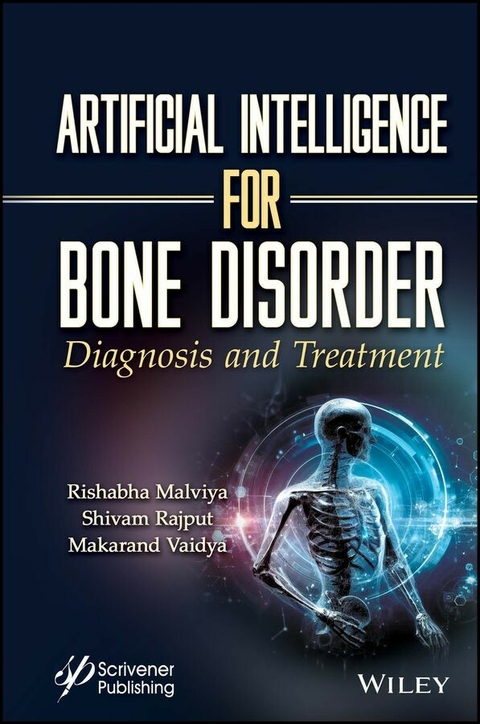
Artificial Intelligence for Bone Disorder
John Wiley & Sons Inc (Verlag)
978-1-394-23088-4 (ISBN)
The book explores the use of artificial intelligence (AI) in the diagnosis and treatment of various bone illnesses. The integration of AI approaches in the fields of orthopedics, radiography, tissue engineering, and other areas related to bone are discussed in detail. It covers tissue engineering methods for bone regeneration and investigates the use of AI tools in this area, emphasizing the value of deep learning and how to use AI in tissue engineering efficiently.
The book also covers diagnostic and prognostic uses of AI in orthopedics, such as the diagnosis of disorders involving the hip and knee as well as prognoses for therapies. Chapters also look at MRI, trabecular biomechanical strength, and other methods for diagnosing osteoporosis. Other issues the book examines include several uses of AI in pediatric orthopedics, 3D modeling, digital X-ray radiogrammetry, convolutional neural networks for customized care, and digital tomography.
With information on the most recent developments and potential future applications, each chapter of the book advances our understanding of how AI might be used to diagnose and treat bone problems.
This book will serve as a guide for orthopedic experts, biomedical engineers, faculty members, research scholars, IT specialists, healthcare workers, and hospital administrators.
Rishabha Malviya, PhD, is an associate professor in the Department of Pharmacy, School of Medical and Allied Sciences, Galgotias University. He has authored more than 150 research/review papers for national/international journals. He has been granted more than 10 patents from different countries while a further 40 patents are published/under evaluation. He has edited multiple volumes for Wiley-Scrivener.
Shivam Rajput completed his MPharm. at Galgotias University, Greater Noida, India. He is currently an assistant professor at IITM College of Pharmacy, Sonipat, Hariyana, India. His areas of research include nanoformulations, cancer nanomedicine, and green nanotechnology for therapeutic applications.
Makarand Vaidya completed his Master of Surgery in Orthopaedics from Hindu Rao Hospital, Delhi where he is currently a faculty member. He has had a distinguished academic career and has published many research papers and books.
Foreword xi
Preface xiii
1 Artificial Intelligence and Bone Fracture Detection: An Unexpected Alliance 1
1.1 Introduction 1
1.2 Bone Fracture 3
1.3 Deep Learning and Its Significance in Radiology 4
1.4 Role of AI in Bone Fracture Detection and Its Application 6
1.5 Primary Machine Learning-Based Algorithm in Bone Fracture Detection 9
1.6 Deep Learning-Based Techniques for Fracture Detection 13
1.7 Conclusion 18
2 Integrating AI With Tissue Engineering: The Next Step in Bone Regeneration 25
2.1 Introduction 25
2.2 Anatomy and Biology of Bone 26
2.3 Bone Regeneration Mechanism 28
2.4 Understanding AI 35
2.5 Current AI Integration 39
2.6 Applying Deep Learning 42
2.7 Conclusion 46
3 Deep Supervised Learning on Radiological Images to Classify Bone Fractures: A Novel Approach 59
3.1 Introduction 59
3.2 Common Bone Disorder 62
3.3 Deep Supervised Learning's Importance in Orthopedics and Radiology 63
3.4 Perspective From the Past 63
3.5 Essential Deep Learning Methods for Bone Imaging 65
3.6 Strategies for Effective Annotation 69
3.7 Application of Deep Learning to the Detection of Fractures 69
3.8 Conclusion 73
4 Treatment of Osteoporosis and the Use of Digital Health Intervention 79
4.1 Introduction 79
4.2 Opportunistic Diagnosis of Osteoporosis 82
4.3 Predictive Models 85
4.4 Assessment of Fracture Risk and Osteoporosis Diagnosis by Digital Health 90
4.5 Clinical Decision Support Tools, Reminders, and Prompts for Spotting Osteoporosis in Digital Health Settings 91
4.6 The Role of Digital Health in Facilitating Patient Education, Decision, and Conversation 93
4.7 Conclusion 95
5 Utilizing AI to Improve Orthopedic Care 105
5.1 Introduction 105
5.2 What is AI? 106
5.3 Introduction to Machine Learning: Algorithms and Applications 109
5.4 Natural Language Processing 114
5.5 The Internet of Things 115
5.6 Prospective AI Advantages in Orthopedics 116
5.7 Diagnostic Application of AI 118
5.8 Prediction Application With AI 121
5.9 Conclusion 124
6 Significance of Artificial Intelligence in Spinal Disorder Treatment 133
6.1 Introduction 133
6.2 Machine Learning 135
6.3 Methods Derived From Statistics 137
6.4 Applications of Machine Learning in Spine Surgery 143
6.5 Application of AI and ML in Spine Research 147
6.6 Conclusion 156
7 Osteoporosis Biomarker Identification and Use of Machine Learning in Osteoporosis Treatment 169
7.1 Introduction 169
7.2 Biomarkers of Bone Development 172
7.3 Biomarkers for Bone Resorption 175
7.4 Regulators of Bone Turnover 179
7.5 Methods to Identify Osteoporosis 180
7.6 Conclusion 187
8 The Role of AI in Pediatric Orthopedics 197
8.1 Introduction 197
8.2 Strategy Based on Artificial Intelligence 200
8.3 Several Applications of Artificial Intelligence 207
8.4 Conclusion 212
9 Use of Artificial Intelligence in Imaging for Bone Cancer 219
9.1 Introduction 219
9.2 Applications of Machine Learning to Cancer Diagnosis 223
9.3 Artificial Intelligence Methods for Diagnosing Bone Cancer 226
9.4 Methodologies for Constructing Deep Learning Model 227
9.5 Clinical Image Applications of Deep Learning for Bone Tumors 229
9.6 Conclusion 236
References 236
Index 245
| Erscheinungsdatum | 06.02.2024 |
|---|---|
| Verlagsort | New York |
| Sprache | englisch |
| Gewicht | 694 g |
| Themenwelt | Informatik ► Theorie / Studium ► Künstliche Intelligenz / Robotik |
| Medizin / Pharmazie ► Medizinische Fachgebiete ► Orthopädie | |
| Studium ► 2. Studienabschnitt (Klinik) ► Anamnese / Körperliche Untersuchung | |
| Technik ► Medizintechnik | |
| ISBN-10 | 1-394-23088-5 / 1394230885 |
| ISBN-13 | 978-1-394-23088-4 / 9781394230884 |
| Zustand | Neuware |
| Informationen gemäß Produktsicherheitsverordnung (GPSR) | |
| Haben Sie eine Frage zum Produkt? |
aus dem Bereich


